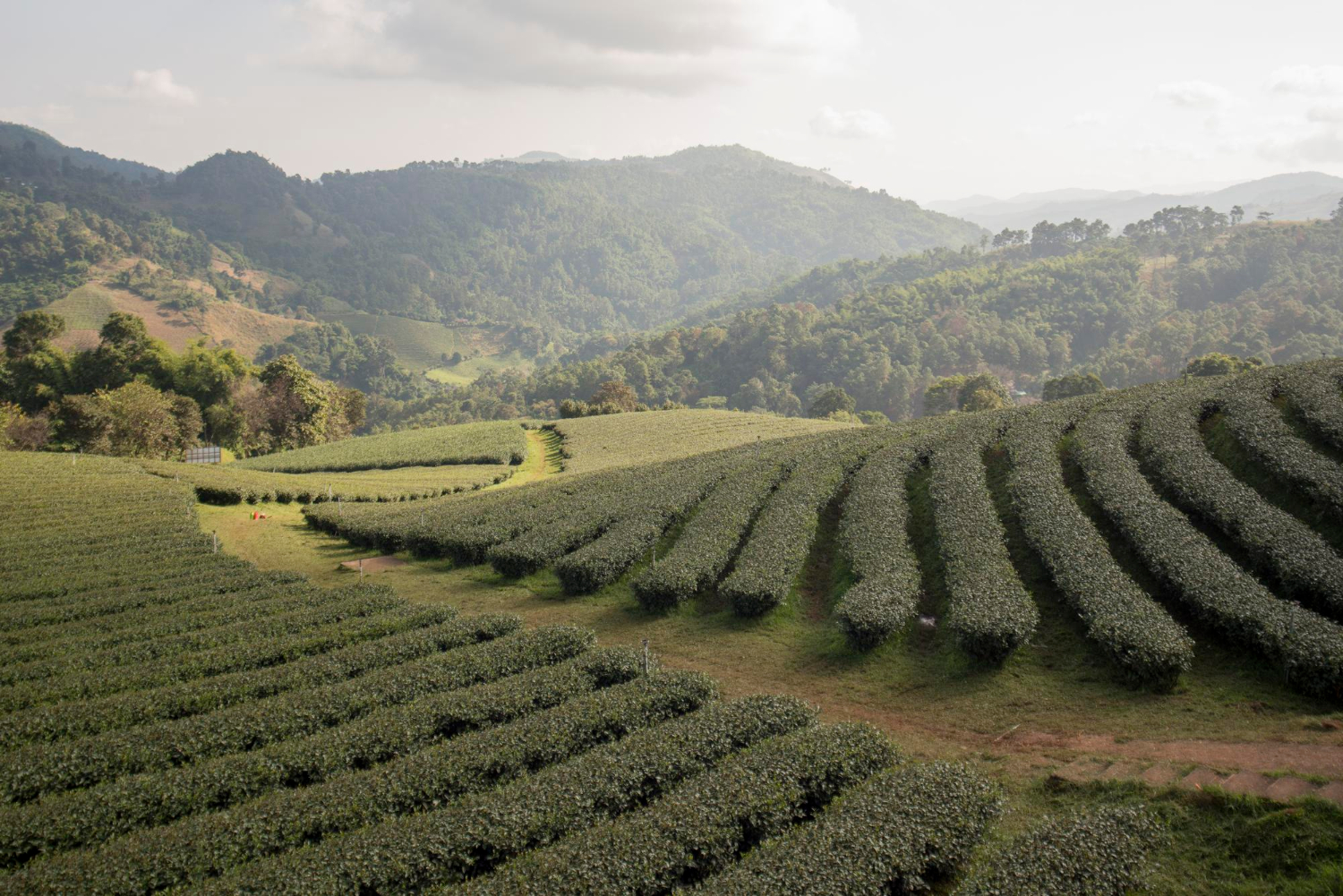Altitude Impact — How Elevation Shapes Arabica Taste & Aroma
Elevation is one of the strongest predictors of Arabica flavor. This guide explains how altitude affects sweetness, acidity, and aroma; outlines ideal elevation ranges for different styles; and profiles real-world examples from Ethiopia, Colombia, Guatemala, Kenya, and Brazil—plus practical buying and QC tips for cafés in Malaysia.

How Altitude Affects Taste & Aroma
As elevation increases, ambient temperature drops and day–night swings widen. This slows cherry maturation, allowing more time for sugars and aromatic precursors to develop. Seeds become denser, with tighter cellular structure, which tends to translate into cleaner acidity, heightened florals and fruit, and better sweetness. Conversely, lower elevations generally produce softer acidity, rounder body, and chocolate–nut leaning profiles that can be ideal for milk-forward espresso.
Mechanisms In The Cup
- Sugar concentration: Slower ripening boosts sucrose, aiding caramelization and perceived sweetness.
- Acid structure: Cooler nights preserve malic/citric acids, giving lively, wine-like brightness when roasted well.
- Aromatics: Precursors accumulate, expressing as florals (jasmine, bergamot), citrus, stone fruit, or berry.
- Roast behavior: Dense coffee tolerates heat and retains structure, offering a wider “sweet spot”.
Elevation is not a guarantee. Aspect, shade, soil, processing, and variety can make a 1,500 m site outperform a 1,900 m site. To see how climate ties in, read our Climate Requirements overview.
Altitude & Sensory Shortcuts
| Altitude | Likely Traits | Menu Use |
|---|---|---|
| 800–1,100 m | Chocolate, nut, low acidity | Espresso base for milk |
| 1,100–1,500 m | Cocoa, caramel, gentle citrus | All-rounder espresso/filter |
| 1,500–1,900 m | Sweet citrus, florals, stone fruit | Feature filter & modern espresso |
| 1,900–2,200+ m | Intense florals, high clarity | Competition/limited features |
See also: Coffee Flavor Wheel • Processing Methods
Ideal Elevations For Arabica Beans
Most specialty Arabica thrives between 1,000–2,000+ m.a.s.l., but the “ideal” range depends on desired flavor, variety, and latitude. Near the equator, similar cup profiles may occur at slightly lower elevations than in subtropical zones due to baseline climate differences. Producers choose variety × elevation pairings—e.g., Typica/Bourbon in cooler highlands; Caturra/ Catuai around mid-elevations; SL28/SL34 and Geisha in high, cool sites—then tune shade and processing to hit cup targets.
Choosing Elevation By Menu Goal
- Milk-forward espresso: Mid or lower-high elevations (1,100–1,500 m) with natural/pulped-natural processing for body.
- Feature filter: Higher elevations (1,600–2,000+ m), washed/honey for clarity and layered acidity.
- Balanced all-rounder: 1,300–1,700 m with washed processing for sweetness and easy dialing.
For more on how temperature and rain interact with elevation, visit Climate Requirements. To compare origins beyond altitude alone, explore Global Growing Regions.
Dense, high-grown lots are less forgiving if underdeveloped. Extend post-crack development slightly to unlock sweetness while maintaining acidity. Validate with our Cupping Guide.
Examples From Different Countries
Ethiopia (1,700–2,200+ m)
Ethiopia’s highlands yield floral, citrus, tea-like washed coffees and berry-jammy naturals. Heirloom/landrace diversity plus elevation produces delicate aromatics prized for filter. Read our Ethiopia Origin guide.
Colombia (1,400–2,100 m)
Andean farms at mid–high elevations deliver cane sugar, orange zest, red apple clarity. Bimodal harvests across departments enable fresher inventory throughout the year. See Latin America Expansion.
Guatemala (1,500–1,900 m)
Volcanic regions like Antigua and Huehuetenango combine elevation and microclimates to give chocolate, baking spice, florals with polished acidity. Great feature filter and blend enhancer.
Kenya (1,600–2,000 m)
Kenyan SL selections at high altitude develop blackcurrant, citrus, wine-like acidity with striking clarity. Processing precision and dense seeds make for competition-grade filters.
Brazil (800–1,400 m, with higher pockets)
Brazil’s vast plateaus skew lower altitude, yielding chocolate-nut, low acidity naturals ideal for espresso base. Higher pockets and selective processing can add red-fruit and nougat nuance. Compare with our Arabica vs Robusta primer.
Indonesia (1,100–1,700 m)
Sumatra’s mid-high elevations plus wet-hulling emphasize syrupy body, cocoa, herbal notes. In Java/Bali/Sulawesi, washed/natural treatments introduce cocoa-spice and gentle florals. Explore Asia-Pacific Growth.
Elevation & Process Matrix
| Target Profile | Elevation | Process |
|---|---|---|
| Chocolatey espresso base | 800–1,300 m | Natural / Pulped-Natural |
| Balanced all-rounder | 1,300–1,600 m | Washed |
| Aromatic feature filter | 1,600–2,000+ m | Washed / Honey |
| Fruity modern feature | 1,400–1,900 m | Natural / Experimental |
Read more: Processing Methods • Filter Brew
Roast & Brewing Implications Of Elevation
High-grown, dense coffees handle heat differently from lower-elevation beans. Expect slower color change, a need for adequate early energy, and potential for crisp acidity if developed correctly. For espresso, aim to preserve structure without tipping into astringency; for filter, keep development sufficient to avoid under-extracted tartness.
Starting Points (Adjust To Your Roaster & Water)
- High-grown washed (1,700 m+): For espresso, 1:2 in ~28–30 s at medium-light; for filter, 1:16 at 92–96 °C.
- Mid-elevation washed (1,300–1,600 m): Espresso medium; filter 1:16 for balanced cups.
- Low/mid naturals: Espresso 1:2 for caramel/chocolate; filter 1:16 with lower brew temps if fruit is too winey.
Standardize evaluation with our Cupping Guide and align descriptors using the Coffee Flavor Wheel. For storage, review Storage Tips and Packaging Options.
When swapping elevations in a blend, change only one variable at a time—keep process constant first—so you can trace which component altered body or acidity.
Buying High-Grown Arabica With Scofi — Practical Guide
Share your menu roles (espresso base, blend sweetener, feature filter), flavor targets, monthly volume and budget. Scofi will shortlist lots—prioritising Malaysia-held stock where available—with full specs: origin, elevation, variety, process, screen size, moisture (~10–12%), defect count, notes, and cup score.
Checklist
- Pick elevation band by role (see matrices above).
- Choose process for clarity vs fruit vs body.
- Approve samples; test roast and cup side by side.
- Lock packaging (GrainPro/vacuum) and storage (Storage Tips).
- Track extraction targets and guest feedback for rebuys.
Learn the backstory in History & Origins and compare regional contexts via Latin America, Ethiopia, and Asia-Pacific.
Spec Targets For High-Grown Lots
| Spec | Target | Why |
|---|---|---|
| Moisture | ~10–12% | Shelf-life & cup stability |
| Defects | Within SCA tolerance | Reduce off-flavors |
| Process notes | Full drying details | Predicts clarity vs fruit |
| Packaging | GrainPro/vacuum | Moisture/oxygen control |
More: Grading Standards • Quality Control
FAQ — Altitude & Arabica
Does higher altitude always mean better coffee?
What elevation should I target for milk espresso?
Which elevations suit delicate filter coffees?
Why are high-grown beans denser?
Do naturals work at high altitude?
How should I adjust roasting for dense, high-grown lots?
Can lower elevations still be specialty?
What specs indicate altitude-driven quality?
How do I explain altitude to guests?
Can Scofi recommend elevation-specific lots?
Keep Exploring Arabica With Scofi
Navigate our most-visited guides for roasters and café buyers.
Temperature, rainfall and risk factors.
Washed, natural, honey & experimental.
Birthplace of coffee and highland florals.
Brazil, Colombia, Guatemala compared.
Indonesia, Vietnam & PNG profiles.
Checklist, sampling and approvals.
Ready To Source Elevation-Driven Arabica?
Tell us your target profile and volume. We’ll shortlist elevation-specific lots from Malaysia stock where available, send samples, and support QC.
